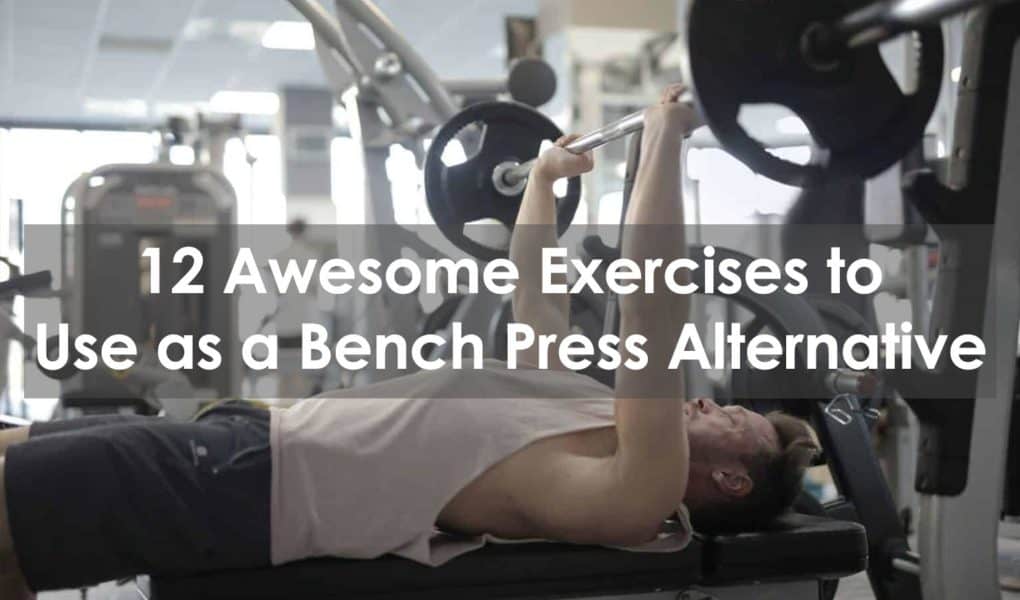The bench press is a staple exercise in any strength program, being a fundamental, upper push compound exercise. But sometimes the gym is packed, or you don’t have a gym buddy to spot you should you get stuck under the bar.
In instances like these, it’s useful to have some go-to alternative exercises you can use to supplement the free weight bench press. These bench press alternatives provide several methods to strengthen the key muscle groups used in various ways.
The exercises in this article can be used as alternatives if the bench press is not able to be performed. Some are straight substitutions for a compound horizontal press, while others are to be used as accessory lifts to strengthen weak points.
1. Dumbbell Bench Press
The dumbbell bench press is a solid alternative to the barbell bench press in several ways. First, it separates each arm, prohibiting your dominant side from taking over the lift. A single-arm dumbbell bench press is also an option here.
Also, it requires more core stabilization and activation of your smaller supporting shoulder muscles to control the weight. For this reason, the dumbbell bench press usually doesn’t require as much weight, and along with the ability to drop the weights on either side should you reach failure, this makes this alternative safer to perform.
Equipment used:
Dumbbell bench presses can be performed with a pair of dumbbells appropriate to the number of reps you wish to perform, and a flat bench. They can also be done lying flat on the floor.
How to perform:
- Lie on the bench or floor with the feet shoulder-width apart and the weights on either side of your chest, elbows at a 45-degree angle from your shoulders.
- Press your feet flat into the floor and engage your core extending your arms straight above your chest.
- Slowly lower the weight back to the starting position. Floor presses will have less range of motion, but also prevent overextending the shoulder.
- Perform anywhere from 6-12 reps depending on your goals.
2. Chest press machine
The chest press machine is a great alternative to bench pressing as it works the same primary upper body muscle groups while safely controlling the range of motion and path of the load.
Equipment used:
The chest press machine. This machine can come in several variations, including seated, lying, pin-loaded, or plate loaded. Some machines also allow single-arm presses by not having the handles connected to each other.
How to perform:
- Adjust the machine to a comfortable position appropriate for your height and limb length, so your hands are in line with your lower chest.
- With your feet flat on the floor and your back pressed into the pad, push the handles until your arms are fully extending. Avoid arching your back.
- Control the weight back to the starting position, keeping the tension on your muscles for the duration of the set.
- For strength, stick closer to 6 reps; for muscle growth, try 8-12.
3. Cable Chest Press
The cable chest press is a good bench press alternative that incorporates the entire core and lower body into your upper body strength output. The machine can be set up at a range of angles, focusing on different areas of your pec muscles while needing the stabilizer muscles to control the movement.
Equipment used:
A cable machine with two handles is needed, setting the handles at the desired height and adjusting the weight pins accordingly.
How to perform:
- Grab the handles and step forward, with one foot in front of the other in a wide stance.
- Starting with your hands on either side of your chest, drive through the floor, brace your core to stay leaning slightly forward, and press your hands forward until your arms are fully extended.
- Slowly return to the starting position without letting the cables pull your torso back, and repeat for anywhere from 10 reps to 15.
4. Push Ups
Push ups have the advantage of being the only exercise on this list which needs zero equipment, and they can be done anywhere. Push ups are a closed-chain version of the horizontal press movement performed in the bench press, anchoring the hands to the floor, with the resistance being provided by body weight.
The push up requires perhaps even more core stabilization than the bench press, lacking the support of the bench for the back. There are not many muscle groups that push ups don’t activate.
Equipment used:
Bodyweight
How to perform:
- Set up in a straight arm plank position, with your hands shoulder-width apart and a straight line from your head to your heels. Keep your feet together.
- Slowly lower your torso down until you have at least a 90-degree bend in the elbows; ideally, your chest should touch the ground to achieve a full range of motion.
- Push up to the starting position, working to fully protract the shoulder blades at the top of the movement.
- Perform until failure.
5. Dips
Dips are similar to push ups in that they are a closed chain upper body exercise, anchoring the hands and moving the body. Unlike the push up, however, dips require some parallel bars or an assisted machine to perform.
To substitute the dip for the bench press, we’ll describe the technique used to focus the exercise on the chest muscles, although it will still utilize the shoulders and triceps.
Equipment used:
Parallel bars or assisted machine
How to perform:
- Set up on the bars with a neutral grip – palms facing each other, hands just behind the hips, and leaning forward.
- Lower yourself until you get a good stretch in the chest. One common error in this exercise is lowering too far, putting a strain on the shoulder joint. Only go down as far as is comfortable.
- Engaging the pecs first, press up as you straighten the arms, fully locking out your elbows at the top of the movement.
- Take your sets to failure of good form, and build up over time.
6. Overhead Press
Another great exercise to build size and improve your upper body strength is the overhead press. The main difference with this bench press alternative is that it is a vertical press as opposed to a horizontal press. While still utilizing the pecs, the overhead press is a great way to build strength in the shoulders and triceps, which can be a sticking point in the bench press.
Equipment used:
Overhead presses can be performed with a range of equipment. We will describe here the dumbbell press variation to allow you to work the arms separately, helping to combat any muscle imbalances.
How to perform:
- Stand with the feet slightly wide and the weights at the shoulders, elbows stacked underneath the shoulders.
- Engaging first from the glutes and keeping the abs drawn in, push the weights straight up until the arms are straight. Slowly lower back to the starting position.
- This move can be performed anywhere from 6 reps for strength up to 12-15 for endurance.
7. Cable Crossover
This chest exercise is one of the alternatives to the bench press that will focus on isolating the singular muscle group of the pecs. It is useful when your sticking point of the bench is at the bottom of the movement, and you want to avoid letting the other muscles do the work for the pecs.
Equipment used:
This exercise requires the same cable machine set up as the cable press, with whichever angle you want to focus on.
How to perform:
- Grab the handles and step forward, with one foot in front of the other in a wide stance.
- Starting with the hands wide, drive through the floor, brace your core to stay leaning slightly forward, and ‘clap’ your hands forward until your arms are fully extended and the handles come together.
- Slowly return to the starting position without letting the cables pull your torso back, and repeat for 10-12 reps.
8. Front Raise
The front raise is one of the best alternative exercises to focus on your anterior deltoids, one of the prime movers in bench pressing. It is also one of the key exercises for a well-rounded, aesthetic body.
Equipment used:
Front raise exercises involve any kind of straight arm shoulder flexion and can be done with a range of equipment. We will describe the dumbbell variation here.
How to perform:
- Stand with the dumbbells at either side of your hips.
- One hand at a time, keep your arm straight and raise the weight in front of you to chest height.
- Slowly lower the weight and repeat on the other side, performing 10-15 reps on each side.
9. Tricep Cable Pushdown
This triceps exercise will make sure there is no sticking point at the top of your bench press, targeting elbow extension while still firing your chest.
Equipment used:
For this exercise, your gym will need a cable machine with a straight bar handle or rope handle.
How to perform:
- Stand facing the cable handle with the hands in a comfortable position, handle in line with the chest.
- Brace your body and keep the elbows tucked to your sides as you extend the elbows down to the front of your hips.
- Control the weight back to the starting position and repeat for 10-12 reps.
10. Incline Bench Press
This version of the bench press will focus on the fibers of the upper chest, connecting the sternum to the clavicle.
Equipment used:
Similar to regular bench pressing, this move requires an adjustable bench that you can adjust at a range of angles.
How to perform:
- Sit back on the incline bench with the barbell across the mid-chest, hands either side.
- Push the feet into the floor, brace the lower back against the pad, and drive the weight straight up, locking out the arms.
- Lower down under control and repeat for 8-10 repetitions.
11. Dumbbell Fly
If your gym doesn’t have a cable machine, this is another great accessory exercise to the bench press that isolates your chest and front shoulders.
Equipment used:
A bench and a pair of dumbbells.
How to perform:
- Lie flat on a bench in the same starting position as to a bench press.
- Reach the arms straight up, then open the arms out wide, bringing the weights down in a wide arc until they are in line with the body.
- Squeeze the chest as you bring the hands back up together at the top.
- Focus on the stretch at the bottom of the movement, and repeat for 10-12 reps.
12. Svend Press
One of the unique alternative exercises on this list, the Svend press, or plate squeeze press creates a different angle of gravity against the push muscles while focusing on creating a strong contraction of the chest throughout the movement.
Equipment used:
You’ll need one or two weight plates, or you can substitute a dumbbell or kettlebell for this exercise.
How to perform:
- Stand with the plate at your mid-chest, pressing your palms together on either side of the flat surface of the plate.
- Squeezing your hands together as if you’re trying to squash the plate, press the weight out in front of you until your arms are fully extended.
- Keeping the contraction in the pecs strong for the entire movement, return to the starting position, and repeat until your strength is maximized.
We hope this article has helped you find some great bench press alternatives to add to your workout routine!
Frequently Asked Questions
What can I substitute for bench press?
The many exercises in this article, or a combination thereof, can be used as alternative exercises for the bench press. Which exercises you use as alternatives will depend on what your home or commercial gym has for you to work with.
How can I bench press at home without a bench?
While technically you can’t ‘bench’ press without a bench, you can work the same compound movements a bench press does without that piece of equipment. A similar bench press alternative that can be done is the floor press. The floor press is done as a regular barbell bench press, just from the floor.
Are push ups a good substitute for bench press?
Push ups are similar to bench pressing in the range of motion, however, they are a closed chain exercise. They are definitely a crucial part of any workout plan, as they strengthen a lot of the supporting muscles such as the serratus anterior. The only downside is that while there are variations to make the exercises harder, you may not be able to lift as much weight with a push up.



